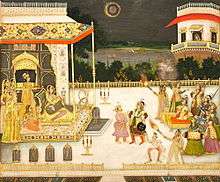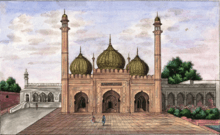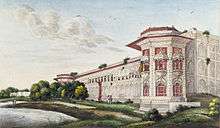Qudsia Begum
Qudsia Begum (died 1765), was a wife of Mughal emperor Muhammad Shah and mother of emperor Ahmad Shah Bahadur. She was an administrator and served as de facto regent of India from 1748 to 1754.
| Qudsia Begum Udham bai | |||||
|---|---|---|---|---|---|
| Tenure | 1724–54 | ||||
| Died | 1765 Agra | ||||
| Burial | Agra | ||||
| Spouse | Muhammad Shah | ||||
| Issue | Ahmad Shah Bahadur | ||||
| |||||

Biography
She may have been born of Hindu origin with her initial name being Udham Bai.[1] She was first introduced to the Imperial Court as a dancer/entertainer and used this position to gain favor among its members. The emperor Muhammad Shah eventually grew fond of her and took her as his third wife. She was later appointed as a Mansabdar, a high ranking position in the Emperor's army that was used to enforce his rule and maintain his authority, especially during his absence.
After Muhammad Shah's death in 1748, her son Ahmad Shah Bahadur (1725–1775) became emperor. As a widow, she took the title Qudsia Begum, alternatively also spelled Qudsiya Begum or Kudsiya Begum. Ahmad Shah Bahadur proved to be an ineffective ruler and was strongly influenced by his mother. A series of defeats and internal struggles led to his downfall. It was rumored that she had an affair with the Nawab Bahadur Javid Khan, who was the eunuch superintendent of the zenana.[1] Javid Khan was later assassinated. When the Nawab Imad-ul-Mulk reached Delhi in 1754, the emperor and his mother were arrested and imprisoned. She probably died after in prison, although the exact date and her gravesite are unknown.[2]
Buildings


She wielded great influence and commissioned various public and private works. The Golden Mosque near the Red Fort was constructed between 1747 and 1751 for Nawab Bahadur Javid Khan.[3]
Her own palace and garden near the Red Fort on the banks of the Yamuna river was constructed in 1748.
See also
- Qudsia Begum, Nawab of Bhopal (ruled from 1819 to 1837 CE)
References
- Latif, Bilkees I. (1 January 2010). Forgotten. Penguin Books India. pp. 50–. ISBN 978-0-14-306454-1.
- Dr. B. P. Saha (1997). Begams, concubines, and memsahibs. Vikas Pub. House.
- "Ahmad Shah (Mughal emperor) - Encyclopædia Britannica". Britannica.com. Retrieved 11 March 2014.